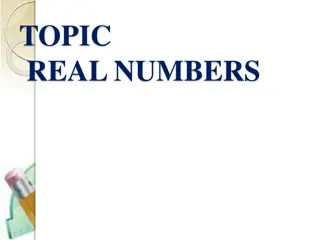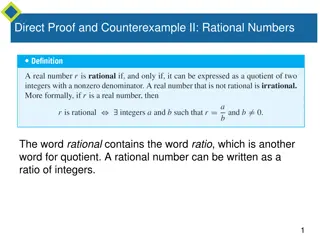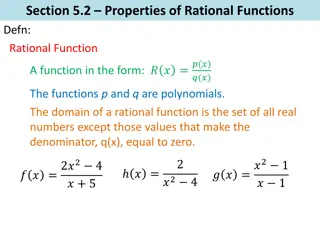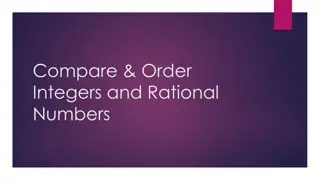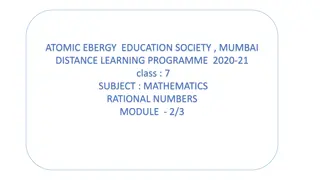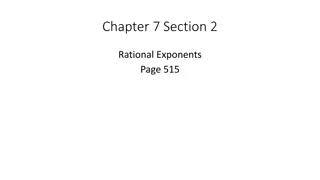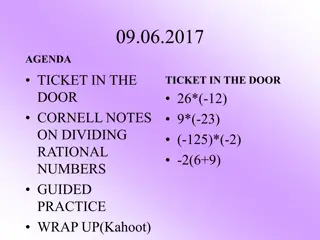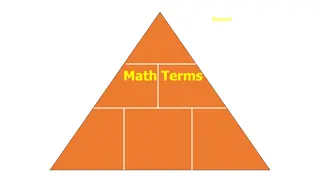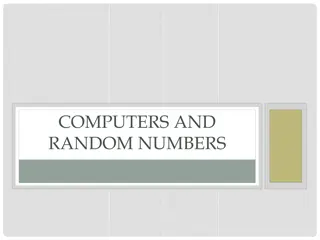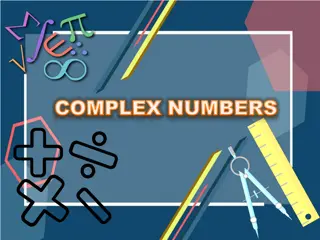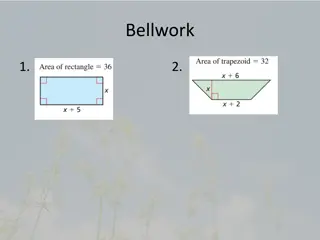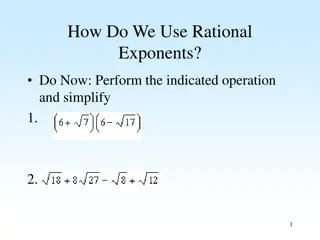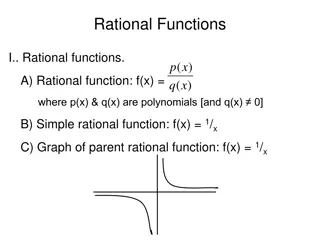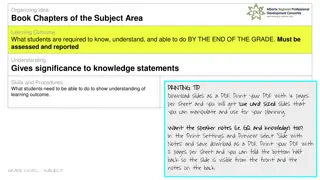Understanding Operations with Rational Numbers
Explore the fundamental operations - addition, subtraction, multiplication, and division - on rational numbers using standard algorithms. Key vocabulary includes rational numbers, adding, subtracting, multiplying, and dividing. Learn the rules for adding and subtracting rational numbers, including dealing with different signs, common denominators for fractions, and aligning decimals. Practice solving sample problems to reinforce understanding.
Uploaded on Sep 15, 2024 | 0 Views
Download Presentation

Please find below an Image/Link to download the presentation.
The content on the website is provided AS IS for your information and personal use only. It may not be sold, licensed, or shared on other websites without obtaining consent from the author. Download presentation by click this link. If you encounter any issues during the download, it is possible that the publisher has removed the file from their server.
E N D
Presentation Transcript
Operations with Rational Numbers Unit 1 Lesson 2
Operations with Rational Numbers Students will be able to: Add, subtract, multiply, and divide rational numbers using the standard algorithm for each operation.
Operations with Rational Numbers Key Vocabulary: Rational numbers Adding Subtracting Multiplying Dividing
Operations with Rational Numbers Adding and Subtracting Rational Numbers The rules for adding and subtracting integers and fractions also apply to adding and subtracting rational numbers.
Operations with Rational Numbers Rules for adding and subtracting rational numbers When adding numbers with the same signs, add the absolute value of each number and take the common sign. When adding numbers with different signs, subtract the smaller absolute value from the larger absolute value and take the sign of the larger absolute value.
Operations with Rational Numbers Rules for adding and subtracting rational numbers To subtract, change to adding the opposite and follow the rules for adding signed numbers. To add or subtract fractions, you must have a common denominator. To add or subtract decimals, it is very important that you are adding values together for the same place value, which means you, must line up the decimal when adding numbers with decimals.
Operations with Rational Numbers Sample Problem 1: Find each sum or difference. ? ? +? a. ?=
Operations with Rational Numbers Sample Problem 1:Find each sum or difference. ? ? ? ? = ? ?? +? a. ?= +? ?= ? ??= + = ? ??
Operations with Rational Numbers Sample Problem 1:Find each sum or difference. b. ?? ? ? ?? =
Operations with Rational Numbers Sample Problem 1:Find each sum or difference. b. ?? ? ?? ? = ?? ?= = ?? ? ? ?? ? ?? ?+ ?? ?+ ?? = = ?= ??
Operations with Rational Numbers Sample Problem 1:Find each sum or difference. ?.?? + ?.?? ?.? = c.
Operations with Rational Numbers Sample Problem 1:Find each sum or difference. c. ?.?? + ?.?? ?.? = = ?.?? ?.?? ?.? = = ?.?? ?.? = = ?.??
Operations with Rational Numbers Sample Problem 1:Find each sum or difference. d. ?.?? ?.?? ?.? =
Operations with Rational Numbers Sample Problem 1:Find each sum or difference. d. ?.?? ?.?? ?.? = = ?.?? + ?.?? ?.? = = ??.?? ?.? = = ?.??
Operations with Rational Numbers Multiplication and Division of Rational Numbers Rules for multiplying rational numbers If the numbers have the same signs then the product will be positive. + + = (+) = (+) If the numbers have different signs then the product will be negative. + = + =
Operations with Rational Numbers Multiplicative Properties: The product of a number and 1 is the number. ? ? = ? Multiplicative Identity Property Multiplicative Property of ? ? ? = ? The product of a number and zero is zero. Multiplicative Inverse Property The product of a number and its reciprocal is one. ? ? ?= ? Multiplicative Property of ? The product of a number and negative one is the opposite of the number. ? ? = ?
Operations with Rational Numbers Sample Problem 2:Find each product. ? ?? ? ? = a.
Operations with Rational Numbers Sample Problem 2:Find each product. ? ?? ? =? ( ?) ?? ? ? ( ?) ?? ? ?= = ? ?? ? a. = =
Operations with Rational Numbers Sample Problem 2:Find each product. b. ?? ?? ?? =
Operations with Rational Numbers Sample Problem 2:Find each product. b. ?? ?? ?? = ?? ?? ? ?? ?? ?? ? ?? ? ? ? ? ? ?? = = = = =( ??) = ??? ?? ? ? ? = = ? ?
Operations with Rational Numbers Sample Problem 2:Find each product. c. ?.?? ?.?? =
Operations with Rational Numbers Sample Problem 2:Find each product. c. ?.?? ?.?? = =??? ??? =??? ?? ??? ??? = ?,??? ??,???= = ?.???? ?? ??? = =
Operations with Rational Numbers Sample Problem 2:Find each product. ?.?? ?.? = d.
Operations with Rational Numbers Sample Problem 2:Find each product. ?.?? ?.? = ? ??? ?? ?? ? ?? ??? ?? ?? ?,???= = ?.??? d. = = = = =
Operations with Rational Numbers Rules for dividing rational numbers If the numbers have the same signs, then the quotient will be positive. + + + + = + ?? = + = + ?? = + If the numbers have different signs, then the quotient will be negative. + + = ?? = + + = ?? =
Operations with Rational Numbers Division is multiplying by the reciprocal. You only have to use the division rule if at least one of the numbers is a fraction or if the quotient will not be an integer.
Operations with Rational Numbers Sample Problem 3:Find each quotient. ? ?? ? ? = a.
Operations with Rational Numbers Sample Problem 3:Find each quotient. ? ?? ? ? = a. ? ?? ? = = ? ? ? ? ? ? = ? ? = =
Operations with Rational Numbers Sample Problem 3:Find each quotient. b. ?? ?? ? =
Operations with Rational Numbers Sample Problem 3:Find each quotient. b. ?? ?? ? = ?? ?? ? ?? ? ?? ? ? ? ? ?? ? ? = = = = ? = = ??
Operations with Rational Numbers Sample Problem 3:Find each quotient. c. ?.? ( ?.?) =
Operations with Rational Numbers Sample Problem 3:Find each quotient. c. ?.? ?.? = = ? ?? ?? = ? ?? ?? ? ?? ?? ?? ? ??= ?? = ?? = = = ? ? ?? = ? ??=
Operations with Rational Numbers Sample Problem 3:Find each quotient. ?.?? ?? = d.
Operations with Rational Numbers Sample Problem 3:Find each quotient. ?.?? ?? = = ?? d. ??? ?? = ?? ??? ? ?? ? ??? ?? = ?.?? ?= ? ??= ? ??? = =




